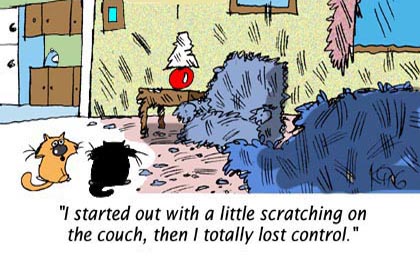|
|
An Ounce of Prevention - Cat
Proof Your Home
Why
do cats destroy household items?
Normal cat
curiosity leads cats to find and
explore household objects with
their mouths and claws.
Curiosity, hunger, and seeking
safety are all natural instincts
that drive exploration.
Why cat proof?
Swallowing
non-food items can lead to
emergency surgery.
Unwanted cat
climbing and exploration can
lead to household destruction.
Cats need outlets for active
minds and meet their basic needs
to
scratch, claw and
climb.
|
The overall strategy is to
supervise the
cat
as he or she explores
the home. Praise the
all
behaviors
you
do
want to continue. Interrupt
any behavior you do NOT
want
and
redirect
to a
wanted behavior. |
What to do
When your cat
is introduced to your home,
supervise teachable moments.
Interrupt
behaviors
to prevent
bad habits such as
clawing furniture or climbing
drapes.
Praise and
offer food treats for behaviors
you do want such as using cat
scratching posts, climbing trees
and cat toys. As your cat
explores, think,
"If this is wrong, what is right?"
Then redirect your cat to what's
right and praise that!
-
Make sure
your home
is completely
cat
proofed.
Remove
strings,
pins,
and
other small objects that may
be accidentally ingested
during play.
-
Provide
cat climbing and scratching
posts and
use praise and treats to
teach and
reinforce good habits
-
Secure
windows,
screens and doors. Cats
love to dash out open
doors. Window screens may
fall out with a rambunctious
cat bouncing off
them
in wild play.
-
Keep household cleaners and
antifreeze
safely locked
up or out of reach.
-
Remove houseplants
- many are poisonous.
Besides that, potting soil
may be more attractive than
the litter
box.
-
Keep dryer door and toilet
seats closed. Curious
cats can bake in
dryers
and drown
in a toilets.
-
Watch out for a hidden
cat
under the rocking chair and
recliner.
What if I
don't want to
cat-proof
my home?
Block
access to
furniture that may
be
scratched
or
that you want
to protect from cat fur. Make
the furniture
unattractive to the
cat by covering
it with
saran wrap or tin foil
when you are not there to
supervise.
Keep your cat
in one safe room or keep doors
closed in rooms you don't want
your cat to access. Keep your
cat confined to a cat condo or
playpen.

|
|
|
"Helping you raise a fabulous feline
friend for life." |
|